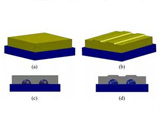|
|
TODAY.AZ / Weird / Interesting
Enhancing robots' senses of touch by giving them human-like fingerprints
22 September 2011 [14:44] - TODAY.AZ
 Researchers at the National University of Singapore are enhancing robots’ sense of touch by mimicking the ridged and contoured surfaces of human fingertips. Fingerprints, it turns out, don’t just give humans better grip but also carry out a sensitive type of signal processing. By imparting that same kind of signal processing to robots, we could reduce the processing loads to robots’ CPUs and help them better identify objects through their shapes.
Researchers at the National University of Singapore are enhancing robots’ sense of touch by mimicking the ridged and contoured surfaces of human fingertips. Fingerprints, it turns out, don’t just give humans better grip but also carry out a sensitive type of signal processing. By imparting that same kind of signal processing to robots, we could reduce the processing loads to robots’ CPUs and help them better identify objects through their shapes.Fingerprints provide a unique identifier and a better means to hold on to objects, but they also shape the ways we sense and perceive the world around us. When we touch something, the ridges alter the vibrations moving through our skin such that nerve endings can better receive them. This serves as a kind of signal processing that allows the skin in our fingertips to provide richer information to our central nervous system than skin on other parts of the body.
For robots, who generally do a lot of processing in a single central processing unit, this distributed signal processing represents a distinct advantage. If robotic sensing surfaces could do more signal processing in the surfaces themselves, it would save on the amount of processing taking place in the CPU, leaving more room there for other kinds of computing.
So the National University team created a robotic touch sensor out of four force-sensitive sensors on a single four-millimeter square plate. Using a thin, flat plastic sheet covering the sensors, they recorded a series of force/touch measurements. They then repeated the measurements, this time covering the touch sensors with a ridged plastic sheet. They found that the ridged measurements where far richer in touch data, even helping the sensor identify the shape of the object being touched.
That all happens right at the “fingertips,” saving the central processor the trouble. And it represents a nice distributed solution that could greatly enhance robotic object recognition. It also represents a nice piece of biomimicry.
/Popular Science/
URL: http://www.today.az/news/interesting/94978.html
 Print version
Print version
Views: 1545
Connect with us. Get latest news and updates.
See Also
- 06 December 2024 [22:20]
Are scented candles harmful to health? - 23 November 2024 [14:11]
Magnitude 4.5 earthquake hits Azerbaijan's Lachin - 20 November 2024 [23:30]
Launch vehicle with prototype of Starship made its sixth test flight - 27 October 2024 [09:00]
Fuel prices expected to rise in Sweden - 24 October 2024 [19:14]
Turkiye strikes terror targets in Iraq and Syria - 23 October 2024 [23:46]
Kazakhstan supplied almost entire volume of oil planned for 2024 to Germany in 9 months - 23 October 2024 [22:17]
Taiwan reported passage of Chinese Navy aircraft carrier near island - 23 October 2024 [21:50]
Russia remains largest oil supplier to India - 16 October 2024 [17:54]
Gamesummit co-founder shares insights on future of gaming industry in Azerbaijan [EXCLUSIVE] - 12 October 2024 [18:27]
TikTok cuts jobs, turns to AI for content moderation
Most Popular
 Pashinyan plants a pig for the Armenians
Pashinyan plants a pig for the Armenians
 Changing global geopolitics & implications for Pakistan
Changing global geopolitics & implications for Pakistan
 Turkish FM meets Syrian leader in post-Assad era
Turkish FM meets Syrian leader in post-Assad era
 New Zealand rejects plan to introduce its own passports for residents of Cook Islands
New Zealand rejects plan to introduce its own passports for residents of Cook Islands
 Gloveman: Macron and his one-time premieres
Gloveman: Macron and his one-time premieres
 Chairman of Israel-Azerbaijan Joint Economic Committee congratulates Azerbaijani President
Chairman of Israel-Azerbaijan Joint Economic Committee congratulates Azerbaijani President
 Macron described as 'extremely paranoid', says French media
Macron described as 'extremely paranoid', says French media
